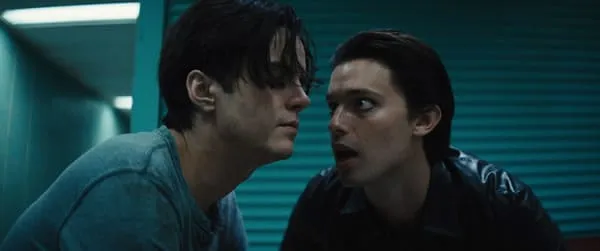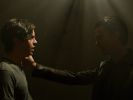Eye For Film >> Movies >> Daniel Isn’t Real (2019) Film Review
Daniel Isn’t Real
Reviewed by: Jennie Kermode

Around two thirds of children have imaginary friends. One of the things they do is to help reassure us that we're safe, providing a listening ear when we have problems we can't share with anybody else. Luke (played as a child by Griffin Robert Faulkner and later, as a young adult, by Miles Robbins) has more need of that than most. His mother (an exceptional Mary Stuart Masterson) is schizophrenic and it's destroying his parents' relationship, leaving him as her primary carer. After accidentally stumbling upon the aftermath of a mass shooting adds to his trauma, he acquires a new friend in the form of Daniel (Nathan Chandler Reid; later, Patrick Schwarzenegger), who, invisible though he is, manages to bring a little joy back into his life. But Daniel sometimes takes games a little too far. After a dangerous incident occurs, Luke's mother brings her knowledge of therapeutic techniques to bear and has Daniel locked away in an old doll's house so that he son can get on with life without him.
Until, of course, Daniel is released.

When, in the 1890s, academics first began to take an interest in the phenomenon of the imaginary friend, it was something associated entirely with adults; the idea that they should belong to the realm of childhood didn't emerge until much later. imagination was not then treated as a childish thing - it was a source of inspiration and something to be encouraged. Luke's struggles with depression as a young man and his feelings of guilt when his mother enters an institution lead his therapist to suggest that he should try giving his creative side more rein. On his advice, Luke releases Daniel, who quickly finds a new role in his life. He's supportive, encouraging, very much what Luke needs. His little tricks are so beguiling and useful that our hero doesn't really question how an imaginary person can achieve such things. But Daniel sometimes takes games a little too far.
It's a couple of centuries now since any significant proportion of the population really believed in possession or the influence of evil spirits, yet even today, there remains a lingering tension between psychiatric and theological views on the subject. Director Adam Egypt Mortimer (who has explored issues around mental health and the supernatural before, in 2015's Some Kind Of Hate) peppers this film with visual references to occult tradition yet also highlights the naivety of a therapist who wants to try something other than Western medicine. The first half of his film is full of teasing questions. Is Luke's fear that he may inherit his mother's illness coming true, or might that be the less horrific of the possibilities here? Can she use her difference, her insight to help him, or has she already parted with too much of her power in an attempt to survive?
Perhaps Luke's best hope lies in another character, the young artist Cassie (Sasha Lane) who takes a shine to him. Their interactions are disarmingly naive, tipping the balance of the film towards something simple and sweet, yet Lane gives Cassie an underlying strength of character that further highlights Luke's vulnerability.
It's also through the presence of this unremarkable yet passionate young artist that we get our only real glimpse into Daniel's character - that is, beyond the American Psycho-style mask he adopts to impress and intimidate Luke. His delight at seeing what he takes to be his own presence captured like a shadow in one of Cassie's paintings leads him to reveal an unexpected streak of vulnerability, a hint of loneliness in someone who might, after all, have no contact with anyone quite like himself. It's an interesting character moment that briefly shifts the balance of the film before Mortimer carries us back to something more conventional. Here, again, Lane comes into her own, presenting Cassie as someone who is very much at the centre of her own story and unwilling to become a mere object for two men to fight over, no matter what the script tells her to do.
Of the leads, it's Robbins who draws the short straw, Luke spending so much of his time as a vessel for audience emotions that he doesn't really get the chance to show what he can do except in the brief moments when Daniel is piloting Luke's body. His work with Schwarzenegger is good, however, allowing for a seamless transition when those moments come. Elsewhere, Schwarzenegger handles his role with a restraint unusual in actors his age, so that even viewers with a strong sense of what's coming will warm to him or wonder how bad he can really be. When the FX team takes over, playing around with imagery that recalls Francis Bacon's Screaming Popes, it's a shame to lose this capable young actor's contribution.
There are a lot of ideas here and there's a lot of strong material, so one can forgive the borrowings and clichés to a degree. In some places they're wholly appropriate; Mortimer's film feels like an answer to some of the more ugly exploitation of mental illness in horror films past. It certainly has more going on upstairs than the average work on this theme. He's not quite there yet, but Daniel Isn't Real suggests that he's well on his way to becoming a filmmaker who really matters.
Reviewed on: 27 Jan 2020


















